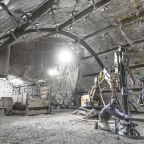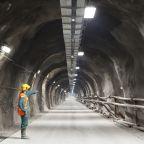Search results
The research and development work of GRS mainly concentrates on the fields of core behaviour, core meltdown processes, transients and leakage events in the cooling circuit, accident behaviour, containment system and structural-mechanical behaviour of components. The development of methods is an important task in this respect. One focus here is the development and validation of simulation codes that deal with reactor safety.
It is unquestionable that a repository for high-level radioactive waste must be safe. This applies both to the phase during which the repository is being constructed and operated and to the phase afterwards, when the waste is enclosed and all drifts and shafts are sealed. In a joint research project, scientists from GRS and BGE Technology GmbH have investigated how these two phases are interrelated and influence each other.

It is unquestionable that a repository for high-level radioactive waste must be safe. This applies both to the phase during which the repository is being constructed and operated and to the phase afterwards, when the waste is enclosed and all drifts and shafts are sealed. In a joint research project, scientists from GRS and BGE Technology GmbH have investigated how these two phases are interrelated and influence each other.
Steam generator tubes in pressurised water reactors are exposed to high stresses such as high temperatures or large pressure differences. In combination with possible corrosive effects due to deposits in the outer area of the tubes, these stresses can at worst lead to leakages, which in turn could have an influence on operational safety. A team of researchers from GRS and the Materials Testing Institute of the University of Stuttgart has therefore conducted in-depth investigations into such leakages with the support of the Federal Ministry for the Environment and the Federal Ministry of Economic Affairs. The scientists have now developed a flow model with which the leakage rate of the escaping medium can be determined even more precisely than previously possible.

In this project GRS is studying the movement of water and gas - and the radioactive materials contained therein - in repositories. The aim of the study was to refine the calculation tools for the safety assessment of repositories.
Shields are devices of various types designed to keep ionising radiation away from people and the environment or to attenuate it.
The activity indicates how many atomic nuclei of a radioactive substance decay in a certain time and thereby transform into new atomic nuclei. The unit of activity is becquerel. The indication of activity alone is not sufficient to make statements about radiation exposure.
Alpha radiation is a form of ionising radiation emitted during the so-called alpha decay of certain radionuclides (also known as "alpha emitters").
The equivalent dose can be used to indicate how tissue-damaging a type of radiation is. To do this, the dose rate is multiplied by a biological factor, the so-called weighting factor. The equivalent dose is measured in sieverts per second.